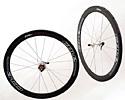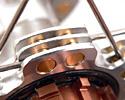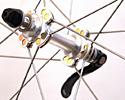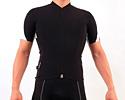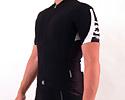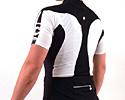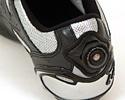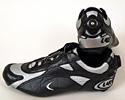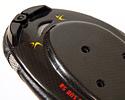
Recently on Cyclingnews.com |
Quick Spins – August 28, 2007Edited by James Huang Got Tech? Send press releases, news, and tech questions to the Cyclingnews tech-heads. Welcome to Quick Spins, an all new section within Cyclingnews' tech coverage were we put some of the smaller items that land on the tech desk to the test.
Proudly standing almost unchallenged atop the ultra-premium clothing world is Swiss-based Assos. In Assos-land, high-tech features and unflappable Euro styling are met with equally high asking prices, but in the case of its new SS.13 jersey, we have to admit that you get what you pay for. Assos incorporates a non-stretch 3D 'senso mesh' back into its new top-end top, which supposedly offers better support when the pockets are brimming with gear, as well as a more structured, wrinkle-free fit and more efficient moisture transfer. As one would expect coming from Assos, the SS.13 delivers a decidedly trim cut that is further enhanced by stretch Macro Spandex shoulders and a rather uniquely cut neck. A full-length zipper and mesh armpit inserts augment the mesh back to keep things cool, while a few reflective accents help to keep things safe after the sun goes down. We'll likely never label a US$279 jersey as inexpensive, but we will say that the SS.13 is simply one of the finest, if not the finest, hot-weather jersey we've used. The liberal expanse of mesh works exceptionally well at moving air through the garment, and the tight fit does, indeed, facilitate the removal of sweat (and therefore, heat) from your body. By whatever means, the SS.13 somehow manages to make the air feel cooler than it really is. Unlike some other tighter-fitting tops we've used, this one also never feels clammy against your skin. Assos' semi-rigid 'senso mesh' construction theory also seems to hold up well. After intentionally loading the pockets up with a big-and-heavy smartphone, a handful of keys, multi-tool, tube, CO2 inflator, gel packets, and a few energy bars (a bag of lead shot perhaps would have been a more space-efficient means of lugging around a bunch of mass), the SS.13 continued to offer up a superb fit with little-to-no sagging to speak of. Lastly, we can't help but mention Assos' impeccable styling. How one company can be so successful at creating timelessly simple-yet-striking garments (and how some others seem to perennially get it so wrong) is beyond our comprehension, but Assos has clearly got it down pat. Does it cost more? Yup, sure does… now where do we get another one? Price: US$279.99
|
|
|
|
|
|
The Lake CX330C is one of just a handful of cycling shoes that continues to use natural materials. In this case, kangaroos give up their hides for the buttery soft K-Lite uppers which are also fitted with temperature-regulating Outlast material in the heel and tongue liner to further improve comfort.
Conventional buckles and straps are scrapped in favor of the increasingly popular BOA system, which emulates the fit of old-school laces and pairs it with modern convenience and light weight. In a bit of an unusual twist, though, Lake mounts the Boa reel on the heel of the CX330. This not only provides the usual Boa benefits, but also serves to pull the rider's foot back into the heel cup for a more secure fit. Lake mates this entire assembly atop a rigid three-hole-compatible full-carbon sole with forefoot and heel vents.
Lake's heel-mounted BOA works great at locking the rear of your foot into the shoe; heel lift was wholly nonexistent and the criss-cross lacing pattern did an excellent job at distributing pressure evenly across the instep. Riders with lower volume feet, however, will likely have to crank up the BOA a few more turns (thus impinging on the front of the ankle a bit in the process) as the CX330C offers up a particularly roomy interior. This does leave plenty of room for bulkier custom insoles, but the especially high-volume fit might not work for many riders.
Otherwise, the CX330C performed admirably and the wide carbon soles proved plenty rigid and supportive. The one exception was a sole insert that stripped out almost immediately during cleat installation. Thankfully it's a fairly easily replaceable bit, but it was annoying nonetheless.
On a more subjective note, we never really quite got on with our test shoes' black-and-silver aesthetic, nor did most of the people we asked to offer up their opinion on how the CX330C looked. Lake also offers the shoe in a bolder orange-and-black colorway and a brighter pearl white-and-silver, but the general pattern remains the same.
Overall, the CX330C proved to be a perfectly competent high-end road shoe with some intriguing (and effective) features. As with any shoe, though, fit is paramount and the especially roomy cut of the Lake CX330C warrants a trial wearing even more than usual. Bigger riders should also take note that Lake offers the CX330C all the way up to sz48. As the saying goes, if the shoe fits…
Price: US$279.99
Weight: 600g (pair, sz44)
Pros: Heel-mounted BOA works well at locking in the heel
and effectively mimics the fit of old-school laces, supply K-Lite
upper material, broad size range
Cons: High-volume interior fit likely won't work for many,
questionable aesthetics, chintzy sole inserts
Cyclingnews rating: ![]()
Photography
For a thumbnail gallery of these images, click here
Images by James Huang/Cyclingnews.com
- The CX330C is Lake Cycling's top non-moldable shoe.
- A unique heel-mounted BOA closure system secures the rider's foot into the heel cup.
- The criss-cross lacing pattern mimics the even pressure distribution of old-school laces.
- The look may not be for everyone , but the performance is mostly there.
- A full carbon sole puts the power down.
- Vents in the forefoot and heel help to keep feet cool.
- The molded heel cup combats heel lift.
- A well-padded tongue virtually eliminates pressure points on top of the foot.
![]()

